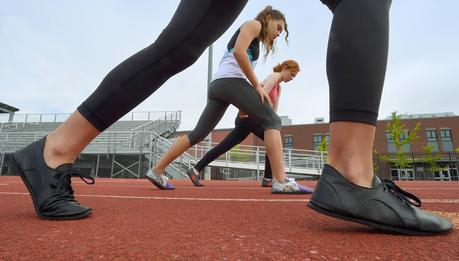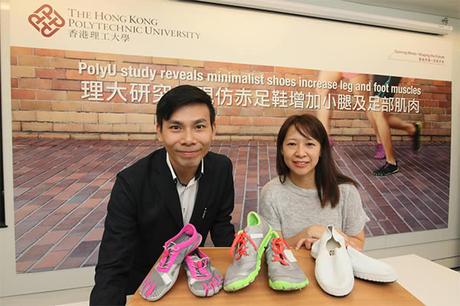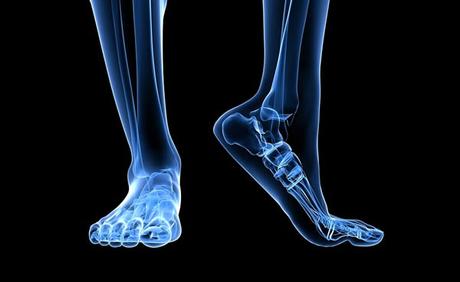
New Study From PolyU Reveals Minimalist Shoes Increase Leg and Foot Muscles, Decrease Chance of Injury
The public debate over minimalist shoes has been on a roller coaster for several years now, but perhaps not for much longer.
Although minimalist shoes for kids have been popular for several decades (we've made a business of it since 1985), the idea that adults—especially runners—could benefit from them erupted in 2009 with the publication of the book Born to Run. Runners began kicking off their shoes to hit trails barefoot and almost overnight every shoe company on the planet jumped on the bandwagon with a wide range of minimal designs. I won't lie to you: that was a good time for Soft Star, and it set the stage for us to expand our product line to include casual and athletic shoes for adults.
- Proof Those 'Barefoot' Running Shoes Are BS
- Barefoot Running Heads Into the Sunset
- Time’s Up, Barefoot Runners. Make Way for Fat-Soled Running Shoes
That fallout was frustrating for a couple reasons. Firstly, Vibram didn't lose the lawsuit because their claims were proven false, only because they made a profit on claims that were not yet proven to be true, and this point was largely missed by the critics. Secondly, we've seen hordes of people coming through our shop who tell us their bunions cleared up, their hammertoes flattened out and their plantar fasciitis pain disappeared after switching to our shoes and throwing away their orthotics. It's hard to ignore that kind of response, and this new resentment toward minimal shoes may have scared away people who could have found relief for their pain.
We think the fact that our sales and customer base have continued to grow in spite of the Vibram lawsuit is a testament to the benefits of minimal shoes (we're currently in the process of moving to a bigger workshop). We've always taken the attitude in our shop that the pendulum will eventually swing back our way as research continues to emerge. Sure enough, every month we hear from more podiatrists, biomechanics and fitness trainers who tell us their clients are improving mobility and foot health after changing from conventional trainers to our shoes.
This month, a big study came out in strong support of minimal footwear, and one that may have saved Vibram from their lawsuit had it been published a few years earlier. Conducted by the Hong Kong Polytechnic University and Harvard Medical School, this study took 38 runners, both men and women with a median age of 35, and put them through the ringer.

Dr Roy Cheung (left), Assistant Professor in PolyU’s Department of Rehabilitation Sciences, and Miss Wylie Tsang (right), participant in the research. Photo credit: The Hong Kong Polytechnic University
The subjects were separated into two groups: one group of 20 who trained in minimal shoes and another control group of 18 who completed the same training in conventional shoes. The minimal shoes contained no heel-to-toe drop and flat insoles with no artificial cushioning or support, whereas the conventional shoes featured a heel-to-toe drop over 5mm with added cushioning and arch support. Both groups followed the same transitional strength training regimen, which included calf and balance exercises. The participants were given MRIs at the start of the study and again after 6 months of training to measure the muscle volume of their legs and feet.
The results were stunning.
On average, the muscle volume of extrinsic foot muscles (between leg and foot) increased by 7.05% among the group that wore minimal shoes, and their intrinsic foot muscles (between heel and toe) increased by a whopping 8.8%! Furthermore, there was a correlation between the subjects' compliance to wear minimal shoes and the results, meaning that the more compliant people were to wear minimal shoes, the greater the muscle volume growth.
The volume of leg and foot muscles in the control group, who wore the conventional shoes, showed no improvement.
Infographic: What Makes a Good Minimal Shoe?
The research team concluded that the lack of artificial arches or mechanical support in the minimal shoes caused the intrinsic and extrinsic foot muscles to work and develop more. In other words, arch supports and cushioning from conventional shoes acted as a crutch that prevented foot muscles from working and strengthening. The minimal shoes, on the other hand, demanded more work, leading to more stabilizing muscles and strengthening of the foot/leg core system.
According to Dr. Roy Cheung Tsz-hei, who headed the study, runners in minimal shoes are less likely to suffer injuries because stronger foot muscles would lessen the impact on bones and tendons.

This isn't groundbreaking news to us—on the contrary, it's what we've heard for many years from experts in the field, including biomechanist Katy Bowman, MovNat founder Erwan le Corre, renowned running coach and author Phil Maffetone, paleo guru Mark Sisson and podiatrist (and Correct Toes inventor) Dr. Ray McClanahan. It is, however, the first time a major study has substantiated these claims on this scale.
We're not saying minimal shoes are for everybody. Even Born to Run author Chirstopher McDougal has always said there is no need to change to minimal footwear or barefoot running if you have no injuries or foot problems with your current footwear. If, however, you suffer from foot pain, knee pain or want a more natural, barefoot-like experience then we hope you'll consider the minimalist route before investing in expensive orthotics and heavily cushioned shoes. While that thick padding may ease your pain at first, this study suggests that such cushioning may only weaken your feet further in the long run.
One word of caution: if you decide to transition to minimalist shoes, don't rush into it! Most injures people develop from minimal footwear result from transitioning too quickly before properly adapting their feet. Check out our previous post for tips on a safe transition:
Tips for Transitioning Safely to Minimalist Shoes
Please note that we are shoemakers, not doctors, and cannot prescribe medical advice. Nothing we say is intended to replace the advice of your medical professional.
Related Posts:
- Walking 101: How to Walk Barefoot (or in Minimal Shoes)
- 8 Benefits of Walking and Running Barefoot on Sand
- Biomechanist and Author Katy Bowman Visits Soft Star Shoes

